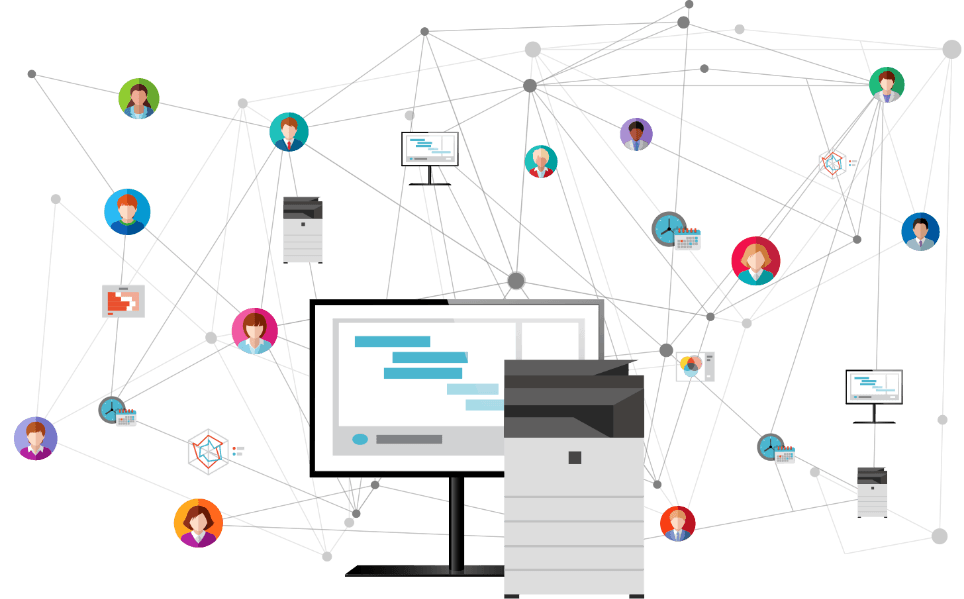One of the key lessons learned from COVID-19 is that chaos breeds innovation. The pandemic has expedited this in the display industry, radically shifting the way we communicate and collaborate. As a result, we need to find new and creative ways to solve modern business problems with a focus on what is coming in the future.
Here are five trends to keep top of mind in the display business to successfully innovate:
Mobility
This means anywhere, anytime, and any device access to information. There has been no greater catalyst than the pandemic for driving this requirement. Even those who were skeptical of the benefits of working from home have been forced to adapt. In many cases, the experience has been extremely positive, after an often painful learning curve. Those who have embraced mobility early have been the most successful with their business continuity plans after lockdowns started. Sharp’s Synappx Go is a great example of this kind of mobility technology, allowing users to share content to Sharp displays directly from a mobile app.
Collaboration
Is starting a meeting in an office conference room as easy as using smart home tech in the house? Probably not. Smart businesses need to make sure that no meeting room is harder to use than a laptop—or true collaboration will suffer. They can do this by leveraging the applications we’ve already learned during quarantine and by using a multi-platform approach, integrating applications such as Zoom and Microsoft Teams to make it easier for employees to collaborate.
[The Integration Guide to Collaboration]
They also need to continue the momentum of video collaboration, equipping conference rooms with simple connectivity and a quality camera/audio experience like we’ve been used to at home, including solutions like Windows collaboration displays.
IoT
We have all become much more aware of having a healthier home, and we will likely take this mentality to our offices, too. But to have healthier workspaces, you need to start with smarter workspaces.
In other words, if you don’t have adequate data about comfort factors in your conference rooms, you won’t know how to make good decisions about how to fix it. This is where Internet of Things (IoT) and artificial intelligence (AI) comes in. IoT involves data collection and analytics, while AI can take those analytics and do smart things with it. For example, displays with sensors that pick up room activity, such as temperature and humidity levels, and process that data in the cloud, can then be accessed to make spaces healthier and more productive.
As-a-Service
With technology, there is never a constant. Every few years, we have to consider upgrades to stay up to date on the newest devices and software that can drive employee collaboration and productivity. But more and more, we are beginning to ask whether we can procure this technology via subscriptions rather than purchases. Many organizations are having serious conversations about utility models and considering if they can just pay for what they use, as they use it.
[The Integration Guide to Flat Panel Displays and Mounts]
In the display world, companies that are moving to this cloud-like usage model demonstrate greater flexibility to meet shifting user needs. Given the popularity of this procurement and deployment model, you may have already bought your last piece of hardware.
AV Meets IT
With the growing digital transformation all around us, we are seeing an acceleration of the convergence of AV and IT. Soon, there won’t be successful AV people that don’t understand IT and vice versa. This is essential as businesses begin to realize that every AV solution—like sensors on displays—is actually a connected solution that complements the data-oriented IT practice. As digital walls begin to come down, we are finding new ways to provide full-stack solutions that end users demand and that improve productivity.
There is a tech renaissance happening in the display industry and it started well before COVID-19. However, the pandemic has added fuel to the fire of innovation. We need to start thinking about where we want to be in the future and how to adjust our core competencies to serve clients according to their future needs.
Bob Madaio is VP of marketing for Sharp Imaging and Information Company of America. After 20-plus years helping market data center solutions at EMC (now part of Dell) and Hitachi, he now leads the marketing team and efforts for Sharp across all products and channels. His role is to accelerate the growth of Sharp's brand and presence within the information technology industry, expand critical technology alliances, and drive innovative programs through Sharp's channel sales network and the Sharp Business Systems direct sales organization.

